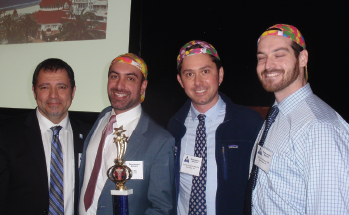
Winning team UCSD with Resident Bowl announcer Albert Merati, MD
UCSD—with a roster made up of Aria Jafari, MD; Andrey Finegersh, MD, PhD; and Daniel Schaerer, MD—squeaked past three other finalists: second-place finisher University of Miami, third-place SUNY Upstate, and fourth-place Washington University.
Explore This Issue
March 2019Since the UCSD hospital sits just 10 miles up the road from where the bowl took place on Coronado Island, it might be tempting to chalk up the victory to home-field advantage. But their home turf probably didn’t feel like much of an edge on the day of the contest: All three team members, who wore tropical-colored caps during the competition, worked early shifts and drove straight to the competition from the hospital, they said.
Dr. Jafari allowed that maybe they were “well-rested-ish,” but said, “We were all at work through today, so I don’t know about that.”
They said the victory felt good, especially as the “home” team. But they said their preparation for the event was minimal. Dr. Jafari gave this deadpan description of how they prepared: “I took an Uber from the hospital to Coronado. We bought the hats from Goodwill.”
The competition was a playful and loud contrast to the sedate scientific sessions of the meeting. Team spirit is highly encouraged, and the Crown Room of the Hotel Del Coronado was enlivened with colorful and outlandish costumes: There was a cactus (University of Arizona), pilgrims (Harvard), a lobster, a Red Sox player, and an American colonist (Boston Medical School), and super heroes (UCLA). Audience members cheered and blew into party noisemakers when correct answers were announced.
The Resident Bowl is a quiz game in which moderators ask multiple-choice scientific questions and allow teams 12 seconds to choose their answer. Teams then hold up an A, B, C or D. The first round consists of 25 questions, and the highest-scoring teams move on to the final round.
SUNY Upstate had the highest score after the first round, with 22 points, but three teams had 21 points, so all four teams moved on to the final round, each with a clean slate. The teams were given three oranges to start. With each incorrect answer, the teams had to surrender an orange—they literally threw them to the moderators on the dais—and the last team with oranges won.
The fourth question in the final round proved pivotal. The teams were shown an image and were asked: “Which of the following patient conditions is most often associated with the following actigraphic tracing?” The UCSD team was the only team to answer correctly—blindness. Washington University was eliminated on that question, and Miami and SUNY Upstate had just one orange and UCSD still had two.
SUNY Upstate was knocked out on the next question, leaving just UCSD and Miami.
The last two teams heard this question next: “For children with chronic rhinosinusitis which has been unresponsive to maximal medical therapy, which of the following is correct regarding adenoidectomy?” Both teams got it right: adenoidectomy is beneficial in children 12 years of age or younger.
So they went on to the next question: “Menthol stimulation of the nose can have which of the following effects?” Both teams chose (C) decreased respiratory drive through TRPV1 (transient receptor potential vanilloid 1). That was wrong—the correct answer was decreased respiratory drive through TRPM8 (transient receptor potential melastatin 8)—and Miami lost its last orange, giving the title to UCSD.
Albert Merati, MD, chief of laryngology at the University of Washington, who helped organize the bowl and acted as one of the lead announcers, clearly enjoyed the event. “There was spirit, planning, knowledge, and a wonderful family feel,” he said.
How many questions would he have gotten right?
“All kidding aside, I would have maybe gotten 10.”